- Home
- About
- Map
- Trips
- Bringing Boat West
- Migration West
- Solo Motorcycle Ride
- Final Family XC Trip
- Colorado Rockies
- Graduates' XC Trip
- Yosemite & Nevada
- Colorado & Utah
- Best of Utah
- Southern Loop
- Pacific Northwest
- Northern Loop
- Los Angeles to NYC
- East Coast Trips
- 1 Week in Quebec
- Southeast Coast
- NH Backpacking
- Martha's Vineyard
- Canadian Maritimes
- Ocracoke Island
- Edisto Island
- First Landing '02
- Hunting Island '02
- Stowe in Winter
- Hunting Island '01
- Lake Placid
- Chesapeake
- Provincetown
- Hunting Island '00
- Acadia in Winter
- Boston Suburbs
- Niagara Falls
- First Landing '99
- Cape Hatteras
- West Coast Trips
- Maui
- Mojave 4WD Course
- Colorado River Rafting
- Bishop & Death Valley
- Kauai
- Yosemite Fall
- Utah Off-Road
- Lost Coast
- Yosemite Valley
- Arizona and New Mexico
- Pescadero & Capitola
- Bishop & Death Valley
- San Diego, Anza Borrego, Joshua Tree
- Carmel
- Death Valley in Fall
- Yosemite in the Fall
- Pacific Northwest
- Utah Off-Roading
- Southern CA Deserts
- Yosemite & Covid
- Lake Powell Covid
- Eastern Sierra & Covid
- Bishop & Death Valley
- Central & SE Oregon
- Mojave Road
- Eastern Sierra
- Trinity Alps
- Tuolumne Meadows
- Lake Powell Boating
- Eastern Sierra
- Yosemite Winter
- Hawaii
- 4WD Eastern Sierra
- 4WD Death Valley +
- Southern CA Deserts
- Christmas in Tahoe
- Yosemite & Pinnacles
- Totality
- Yosemite & Sierra
- Yosemite Christmas
- Yosemite, San Diego
- Yosemite & North CA
- Seattle to Sierra
- Southwest Deserts
- Yosemite & Sierra
- Pacific Northwest
- Yosemite & South CA
- Pacific Northwest
- Northern California
- Southern Alaska
- Vancouver Island
- International Trips
- Index
- Tips
- Books
- Photos/Videos
- Search
- Contact
Mykonos and Delos, Greece
Thursday, September 8, 2022 - 10:45am by Lolo
114 miles and 5.5 hours from our last stop - 2 night stay
Travelogue
Day 1 - Arrival on Mykonos, enjoy our private pool, and stroll through Old Town and Little Venice
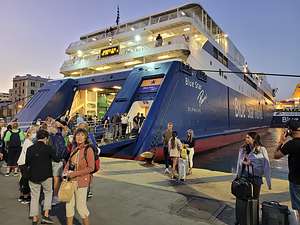 Our early morning ferry to MykonosAs part of our education, Tassos (our tour guide) felt it important that we learn the modern culture of the various islands in the Aegean, and how they have evolved differently. So, during our tour we would visit four islands - Mykonos, Paros, Santorini, and Crete and immerse ourselves in each of their histories and cultures. The Road Scholar tour was not a cruise, but rather we would be taking ferries from island to island.
Our early morning ferry to MykonosAs part of our education, Tassos (our tour guide) felt it important that we learn the modern culture of the various islands in the Aegean, and how they have evolved differently. So, during our tour we would visit four islands - Mykonos, Paros, Santorini, and Crete and immerse ourselves in each of their histories and cultures. The Road Scholar tour was not a cruise, but rather we would be taking ferries from island to island.
The first island on our list was Mykonos - and what a place to start! For more than 50 years, the island of Mykonos has been one of the most popular destinations for the rich and famous - the most famous of which was Jacky Kennedy. We were very ready to immerse ourselves in this culture.
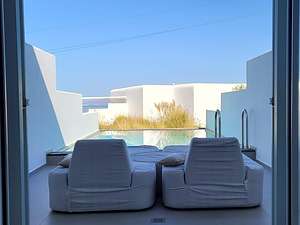 Our private poolMykonos was a 5 ½-hour ferry ride from Athens, so we received a wake up call at 5:00 am to catch the 7:00 am ferry from Athens to Mykonos, thereby allowing us to have almost a full day on the island.
Our private poolMykonos was a 5 ½-hour ferry ride from Athens, so we received a wake up call at 5:00 am to catch the 7:00 am ferry from Athens to Mykonos, thereby allowing us to have almost a full day on the island.
Our bus was waiting for us at the port to deliver us up the steep narrow road to our home for the next 2 nights - the lovely Mykonos Korali Hotel. The logistics were perfect. Our luggage was taken from us at the Acropolis Select, stored on the ferry, and then magically waiting for us in our hotel room upon arrival.
When we arrived at the hotel, we were brought to our room by a staff member who felt the need to explain how things worked - like the well-stocked mini-fridge. Herb was really hoping for a nice view behind the closed curtains, but when she opened them, we saw this lovely private pool, just for us. We felt like we had chosen the right door on Lets Make a Deal. I knew where Herb would be spending the rest of the day.
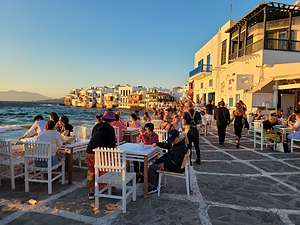 Old Town MykonosThis was definitely not our usual style of travel - usually I’m sleeping in the back of our 4Runner in some remote wilderness. But this was after all an educational tour, so I was willing to learn to immerse myself in the modern culture of Mykonos - and, of course, the pool.
Old Town MykonosThis was definitely not our usual style of travel - usually I’m sleeping in the back of our 4Runner in some remote wilderness. But this was after all an educational tour, so I was willing to learn to immerse myself in the modern culture of Mykonos - and, of course, the pool.
After a two hour refreshing break, we joined our tour group to take our tour bus back down to Old Town Mykonos to wander along the waterfront. We took our tour bus because although the walk wasn’t very far, it was down a steep, narrow road with no shoulder - and did I mention that Greek drivers are a little crazy.
.thumbnail.jpg) Alleyways of Old Town MykonosThe Old Town (called Chora by locals) is a traditional Cycladic Village, with mazes of narrow streets, cubic whitewashed houses, colorful doorways, bougainvilleas, and small white churches. And of course, the famous 16th century windmills, which I will get to later.
Alleyways of Old Town MykonosThe Old Town (called Chora by locals) is a traditional Cycladic Village, with mazes of narrow streets, cubic whitewashed houses, colorful doorways, bougainvilleas, and small white churches. And of course, the famous 16th century windmills, which I will get to later.
We walked along the lovely waterfront, lined with boutiques and restaurants, before heading into and getting lost in the maze of stone alleyways. It was hard to get too lost though, because eventually we always popped out along the waterfront.
One particularly nice section of Old Town was Little Venice, officially known as Aléfkántra. Its brightly painted former fishermen’s houses with balconies jutting out over the sea provided a colorful backdrop to the bustling bars and restaurants that line the waterfront between it and the windmills.
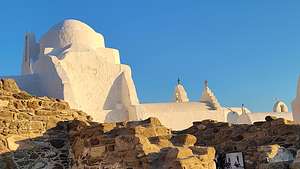 Church of Panagia ParaportianiThe town became more and more crowded as sunset approached, and I can understand why. It was hard to pick where to be for the best view of sunset.
Church of Panagia ParaportianiThe town became more and more crowded as sunset approached, and I can understand why. It was hard to pick where to be for the best view of sunset.
We decided on the windmills, so we set off along the waterfront, stopping first to photograph the beautiful pure white Church of Panagia Paraportiani, one of the most photographed churches in the whole world.
The Church, which dates back to the 1400s, is considered a perfect example of Cycladic architecture. Its asymmetrical shape is due to the fact that it is not just one church, but rather a series of five tiny churches squeezed together - four below and one on top. At the center is the church of Agios Efstathios, surrounded by the churches of Agia Anastasia, Agios Anargyros, and Agios Sozon, and with the Church of the Virgin Mary standing out at the top with a dome.
.thumbnail.jpg) Iconic windmills of MykonosWe hurried to get to the iconic windmills of Mykonos, just in time for sunset. I have never seen windmills like this before. These five windmills, collectively known as “Kato Miloi,” were built by the Venetians in the 16th century to mill the grain produced on Mykonos, which was then distributed throughout the Aegean and even to Asia.
Iconic windmills of MykonosWe hurried to get to the iconic windmills of Mykonos, just in time for sunset. I have never seen windmills like this before. These five windmills, collectively known as “Kato Miloi,” were built by the Venetians in the 16th century to mill the grain produced on Mykonos, which was then distributed throughout the Aegean and even to Asia.
No longer milling grain, the windmills are now an extremely popular and highly photographed tourist destination. We had to jockey for a position to take a photograph.
It was time to find our group again to take our bus back up the short windy hill to our hotel. Herb and I couldn't resist a glass of wine out on or poolside lounge chairs before calling it a day - and a wonderful day it was at that.
Tomorrow we would take a day trip to the island of Delos.
Day 2 - Side Trip to Delos
.thumbnail.JPG)
Although Delos is only 5 kilometers long, it has served an extremely important role in Greek history.
Before our trip, I knew Delos as the birthplace of two very important Greek divinities: Artemis, the goddess of wild animals, the hunt, chastity, and childbirth; and her brother Apollo, the god of music, poetry, healing, and prophecy. As a result, it was an important religious and cultural center from the 3rd millennium BCE right up to the 5th century BC.
.thumbnail.jpg) Sanctuary of ApolloHowever, what I didn’t know is that it was also a thriving commercial center, with an estimated 750,000 tons of merchandise passing through the port each year during the first century BC. During that time, the population of this tiny island was 30,000. Today it is 14.
Sanctuary of ApolloHowever, what I didn’t know is that it was also a thriving commercial center, with an estimated 750,000 tons of merchandise passing through the port each year during the first century BC. During that time, the population of this tiny island was 30,000. Today it is 14.
We began our exploration of the island in the commercial section of the island where many rich merchants lived. There were streets, rich houses with mosaics, and even a theater district. The island was inhabited until the 7th century CE.
Separated from the commercial center was the Sanctuary of Apollo, the religious center of the island. We passed the Terrace of the Lions, a series of four lions carved in the 6th century BCE of marble from the nearby island of Naxos. Their purpose was to guard the sacred area. These lions are actually reproductions. The original ones are in the Archaeological Museum on the island.
.thumbnail.jpg) Terrace of the LionsFurther along, we came across some Amphoras near a stone wall. Amphoras were often used to contain funeral offering for the deceased, or in this case, probably an offering to Apollo
Terrace of the LionsFurther along, we came across some Amphoras near a stone wall. Amphoras were often used to contain funeral offering for the deceased, or in this case, probably an offering to Apollo
And, of course, there was the inevitable phallus (although this one was a bit broken), a common symbol of fertility in Ancient Greece. The rooster was also sacred to the ancient Greeks and symbolized vigilance.
.thumbnail.jpg) Phalluses were a common symbol of fertilityWe were running out of time before our ferry (the last one of the day) was scheduled to leave, so unfortunately we would not have time to hike up Mount Knythos, the small mountain, and the highest point on Delos, that was calling out to us. This mountain is the mythological birthplace of Apollo and Artemis.
Phalluses were a common symbol of fertilityWe were running out of time before our ferry (the last one of the day) was scheduled to leave, so unfortunately we would not have time to hike up Mount Knythos, the small mountain, and the highest point on Delos, that was calling out to us. This mountain is the mythological birthplace of Apollo and Artemis.
That was the tough part about being on a tour. Everything is pretty tightly scheduled so you don't have as much flexibility.
After we got back to our hotel on Mykonos, we had a bit of free time to relax and a tough choice to make - swim in our private pool or do laps in the larger hotel pool, which we had to share with other people. Good God. We were getting spoiled. Wanting to get some well-needed exercise, we chose the larger pool.
We didn't have too much time though because we were scheduled to meet at 7:00 on the hotel's outdoor reception area for a lecture on the challenges that modern Greece has faced in the last two centuries - we were Road Scholars after all.
This was where Herb almost mutinied for the first time. We love sunsets, and we love a nice glass of wine to watch the golden light before the sun dips below the horizon. The problem was that Tassos' lecture, which was held on a lovely outdoor patio, coincided with sunset. I could see Herb getting antsy as the sky began to take on a golden glow. Finally, unable to contain himself, he excused himself and went to retrieve two wines from our hotel room’s mini-fridge, so we could listen, while having a proper cocktail hour while watching the sunset. Maybe Herb wasn’t “scholar” material afterall.
Day 3 - Walk down to Old Town Mykonos and ferry to Paros
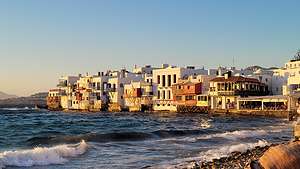 Little VeniceToday we would catch a morning ferry to the island of Paros. However, I realized that I had enough time to walk down to the Old Town to photograph it in the morning light before the crowds started filling up the streets.
Little VeniceToday we would catch a morning ferry to the island of Paros. However, I realized that I had enough time to walk down to the Old Town to photograph it in the morning light before the crowds started filling up the streets.
I asked Herb if he wanted to join me, but he was already sitting with a cup of coffee in his bathrobe on the lounge chair by our private pool. In other words, he wasn’t going anywhere. I think I was going to have to carry him kicking and screaming off this island.
So, off I went alone down the narrow, winding, shoulderless road to Old Town. It was so lovely - no crowds, just local proprietors getting ready for the onslaught that would later occur.
I wandered through Little Venice, along the quiet stone alleyways, and back to the iconic old windmills. It was so peaceful and serene.
Mykonos had been a lovely stop. Now onto Paros.
- ‹ previous
- 2 of 6
- next ›
Mykonos and Delos location map in "high definition"
Javascript is required to view this map.
